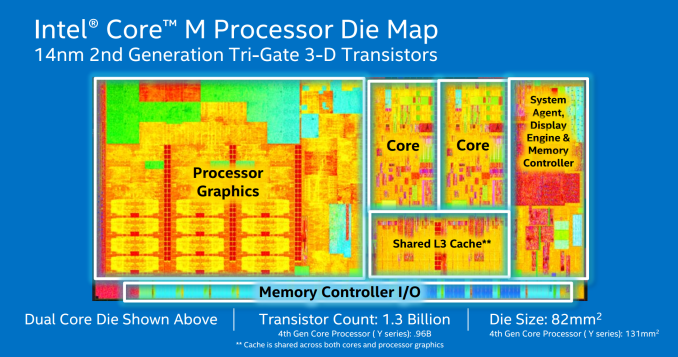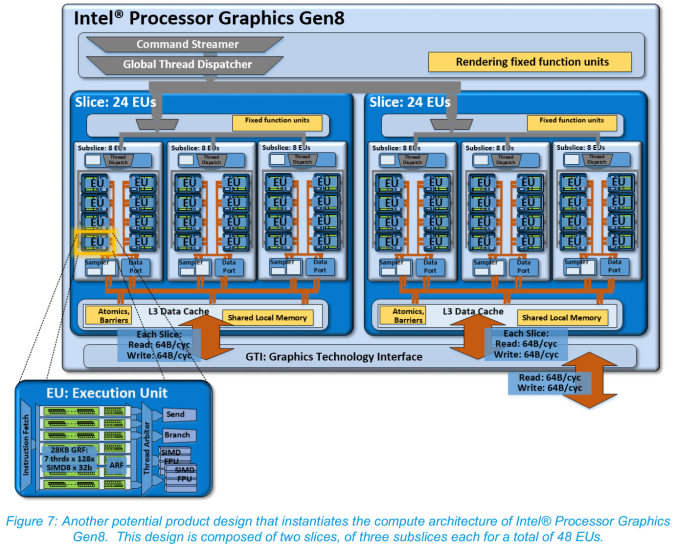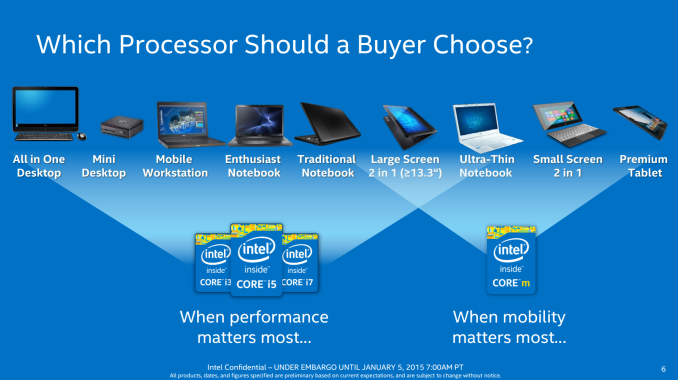Analyzing Intel Core M Performance: How 5Y10 can beat 5Y71 & the OEMs' Dilemma
by Brett Howse & Ian Cutress on April 8, 2015 8:00 AM EST
A processor architect can battle between two major opposing principles. The one most of us seem to enjoy is performance, which when taken to the extreme exhibits an all-or-nothing approach. At the other end is low-power operation which has become the main focus of the laptop and notebook market where battery capacity and density is at a premium. The position in the middle of this is efficiency, trying to extract the best of performance and power consumption and provide a product at the end of the day which attempts to satisfy both.
Of course processor architects only have control up to the point where the chips leave the fab, at which point the final product design is in the hands of OEMs, who for various reasons will have their own product design goals. It's this latter point that has resulted in an interesting situation developing around the Core M ecosystem, where due to OEM design goals we've seen the relative performance of Core M devices vary much more than usual. In our tests of some of the Core M notebooks since the beginning of the year, depending on the complexity of the test, the length of time it is running and the device it is in, we have seen cases where devices equipped with the lowest speed grades of the Core M processor are outperforming the highest speed grade processors in similar types of devices, an at-times surprising outcome to say the least.
Never content to leave things alone, we wanted to take a look at the performance in Core M in depth and how device design - particularly cooling design - can significantly impact performance. So for today we will be diving deep into Core M, to see what we can test and what can be said about system design as a whole for the mini-PC, notebook, tablet and 2-in-1 ecosystem.
Core M
First, let us loop back to the design of Core M, which historically sits in the ‘Y’ processor stack and goes by the codename Broadwell-Y. Core M only comes in dual core flavors with Hyperthreading, with an official TDP of 4.5 watts. Each model comes with 4MB of L3 cache and Intel’s 8th generation of graphics architecture under the designation HD 5300.
HD 5300 is technically a 24 execution unit design, consisting of a major slice with three sub-slices of eight execution units each. This is double the GT1 / HD (Haswell) design where Intel enables only 12 units (which has benefits when it comes to enhancing yields), or half the full GT3 implementation which keeps the same front end but doubles the major slices. A full on 48-EU design looks something like this, although Core M only has one major slice.
The three main differentiators between each of the SKUs in the Core M line are the processor base frequency, the processor turbo frequency and the integrated graphics frequency range. A number of the processors also support cTDP Up and cTDP Down modes which adjust the base frequency of the processor only. Core M supports Turbo Boost Technology 2.0 which allows individual cores of the silicon to increase in frequency within specified parameters, which may include workload, estimated current/power consumption, and temperature. These two points are key to the rest of the article.
| Core M Specifications | |||||||
| Model Number | 5Y71 | 5Y70 | 5Y51 | 5Y31 | 5Y10c | 5Y10a | 5Y10 |
| Cores/Threads | 2 Cores / 4 Threads | ||||||
| CPU Base/ Boost Frequency |
1.2 GHz 2.9 GHz |
1.1 GHz 2.6 GHz |
1.1 GHz 2.6 GHz |
0.9 GHz 2.4 GHz |
0.8 GHz 2.0 GHz |
0.8 GHz 2.0 GHz |
0.8 GHz 2.0 GHz |
| GPU Base/ Boost Frequency |
300 MHz 900 MHz |
100 MHz 850 MHz |
300 MHz 900 MHz |
300 MHz 850 MHz |
300 MHz 800 MHz |
100 MHz 800 MHz |
100 MHz 800 MHz |
| TDP | 4.5 W | 4.5 W | 4.5 W | 4.5 W | 4.5 W | 4.5 W | 4.5 W |
| cTDP Down (CPU Base) |
3.5 W 600 MHz |
No | 3.5 W 600 MHz |
3.5 W 600 MHz |
3.5 W 600 MHz |
No | No |
| cTDP Up (CPU Base) |
6.0 W 1.4 GHz |
No | 6.0 W 1.3 GHz |
6.0 W 1.1 GHz |
6.0 W 1.0 GHz |
No | No |
| Intel vPro | Yes | Yes | No | No | No | No | No |
Core vs. Atom
In general, Core M is a small departure from Intel (pun intended), bringing its main Core processor architecture, typically used for big core performance, down to power levels and chip sizes better suited for fanless laptops and tablets. Despite the drop in core counts and frequency to reach 4.5 watts, the Core M line typically has a single threaded performance advantage at this power segment as compared the competition, which is no simple achievement.
For Intel, this 4 to 5 watt TDP window for processors has typically been occupied by the Atom line of integrated SoCs. In 2014 this meant Silvermont cores in a Bay Trail system produced at the 22nm process node, but for 2015 will mean Airmont cores in a Cherry Trail system at 14nm. For most of 2014, Atom competed against high powered ARM SoCs and fit in that mini-PC/tablet to sub 10-inch 2-in-1 area either running Android, Windows RT or the full Windows 8.1 in many of the devices on the market.
Despite Intel’s initial long cadence with Atom, we are seeing them step up to the plate and provide an iterative cycle that allows for the latest node technologies combined with the updated graphics technology from the integrated Core ecosystem. Nevertheless, Intel has split this 4 to 5 watt TDP segment into two clear formats based on performance and price.
Atom sits at the lower price band ($50-$100 per chip), typically in a dual or quad core arrangement without hyperthreading and uses ‘modules’ of two discrete cores sharing an L2 cache. The integrated IO is designed to be enough for this market segment, as seen in the recently announced Surface 3, and shows that devices in the $500 region are ripe for the next Atom SoCs. Note that Braswell, which also uses Airmont cores at 14nm but goes under the Celeron/Pentium nomenclature, also sits in this 4 to 6 watt region but is aimed more at the mini-PC arena.
Intel lists all of the Core M processors at $281, and a user will be hard pressed to find a Core M device priced under $700 on the market now; such is the gap that Intel wants to strike with the two platforms. Core M sits at the heart of the new Macbook (read our hands on), as well as most of the devices in this test such as the ASUS UX305, Lenovo Yoga 3 Pro and the Dell Venue 11 Pro 7000. With the Broadwell architecture and hyperthreading under its belt, the results do speak for themselves as Core M attacks the Haswell-U line from the last 18 months in terms of direct performance.













110 Comments
View All Comments
serendip - Wednesday, April 8, 2015 - link
Maybe Intel made too many compromises and OEMs reached too far with their designs. On one hand a fast race to sleep is good, yet on the other hand, I'd rather be a slow and steady tortoise who finishes the race than a hare that turbos and sleeps frequently to prevent overheating. Device buyers don't care about TDP or poorly set skin temperature limits, they'll just swear off Core M products that give them throttled 600 MHz speeds instead of full power.boblozano - Wednesday, April 8, 2015 - link
Good point, though I tend to think it'll depend on the use cases. I went back to separate desktop(s) / laptop (rather than a single, uber-laptop) about a year ago. Consequently the laptop can be optimized for size / weight / mobility, for which a core-m device is helpful.jospoortvliet - Thursday, April 9, 2015 - link
Exactly the same here. I will do my video and image editing on my quad-core desktop anyway, so a core M is perfect: I need portability and battery life in a laptop, not raw performance. Intel made just the right chip for a customer like me here. Too bad that on the desktop side, where I would love an affordable six or eight core with a high tdp, they fail me.girishp - Monday, April 13, 2015 - link
I tried doing the same thing, but portability quickly triumphs any advantage of a powerful desktop, especially when a good powerful laptop can do most of what I need. I bought the 2nd gen Mac Book Air for my wife and it was good for her basic multimedia requirements (Photoshop, Final Cut Pro, etc.), but the latest Mac Book just isn't powerful enough for any of her needs.MrSpadge - Wednesday, April 8, 2015 - link
Turbo gives the system increased responsiveness under bursty loads, i.e. most everyday workloads. There's no good reason not to use the performance available and be a tortoise voluntarily. When the load is sustained over longer periods, Turbo automatically throttles back to what ever limit the OEM has set. Had you choosen the tortoise mode, you would have started at this point. With Turbo you don't loose any performance compared to this scenario, it just makes you reach the limit quicker. Turbo also autoamtically factors in things like "how many cores are loaded", "how stresful is this program in reality", "how good is the device cooling" and "how hot is the ambient" by simply measuring them empirically (power consumption & temperature). In fixed tortoise mode you'd have to predict all of them and assume the worst case, just like Intel & AMD did for the first dual and quad cores with low fixed frequencies.If Turbo results in "turbos and sleeps frequently to prevent overheating" it is simply set up badly, significantly worse than Turbo on Intel Desktop CPUs since a few years. Instead of sleeping to avoid overheating the turbo bin must gradually be lowered until a good steady state is reached.
MrSpadge - Wednesday, April 8, 2015 - link
Forgot to add: it would be really nice if there was a simple user control for their current preference of maximum performance vs. tolerated temperature. Win allows limiting a CPUs maximum performance state, but most users will never find this option in the advanced energy settings. A simple slider as a sidebar-like gadget could work well. Not only for Core-M, but also for regular laptops and desktops. Add one slider for each discrete GPU's power target.mkozakewich - Wednesday, April 8, 2015 - link
Also, MS removed that option in all their PCs with connected standby. You can still enable it through the registry, but regular users are even less likely to make use of that option. We need some sane defaults set so we can have separate "Low Power", "Balanced" and "Overdrive" modes. We won't care about skin temperature if we've chosen to use that temperature briefly and we have an option to turn it back down.soccerballtux - Wednesday, April 8, 2015 - link
the biggest problem is Windows packaging in tons of storage indexing that runs every time you log in, or letting services run around in the background and datamine (Facebook, Amazon Music re-scans every 10 minutes-- I mean seriously? might as sell me a phone with 100MB less of RAM if you're going to do that)The_Assimilator - Wednesday, April 8, 2015 - link
Because it's obviously Windows' fault that it runs services that you told it to install.lilmoe - Thursday, April 9, 2015 - link
+1